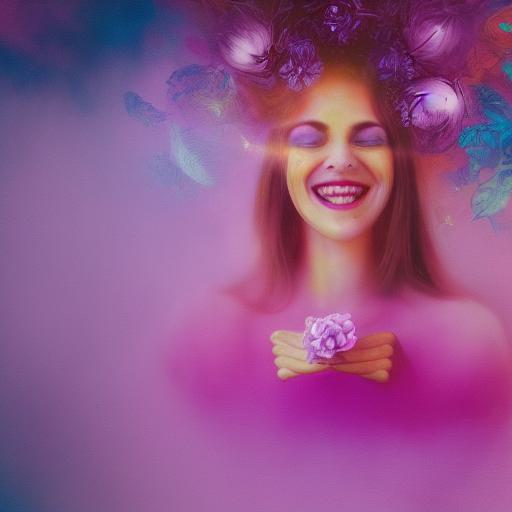How to write this prompt?
Here’s a breakdown of the AI image prompt and how each individual part influences the image being generated:
- Subject: “The woman holding a laughing flower”
- The subject of the image is a woman holding a flower, which will be the central focus of the artwork.
- The woman’s pose and expression will also be important in conveying the mood and tone of the image.
- Close-up: “In a close-up psychedelic artwork”
- The image will be a close-up of the woman and the flower, highlighting the details of their features.
- Psychedelic Artwork: “With a highly detailed view of her expression”
- The artwork will have a psychedelic style, which means bright colors, unusual shapes and patterns, and a dreamlike quality.
- The woman’s expression will be highly detailed and emotive, allowing the viewer to connect with her on a deeper level.
- Color Scheme: “The color scheme has changed to shades of pink and purple”
- The dominant colors in the image will be pink and purple, which will create a surreal and dreamy atmosphere.
- The use of color is an important factor in conveying the mood and tone of the image.
- Background: “The volumetric fog in the background creates a mystical atmosphere”
- The background of the image will be shrouded in volumetric fog, which will create a mystical and otherworldly atmosphere.
- The use of fog and other environmental elements can add depth and complexity to the image.
- Lighting: “The use of backlighting with bokeh effect adds to the psychedelic effect”
- The lighting in the image will be positioned behind the woman, creating a backlighting effect that will highlight the details of her hair and the flower.
- The bokeh effect, which blurs the lights in the background, will add to the dreamlike and surreal quality of the image.
By considering each of these elements and incorporating them into an AI image prompt, it’s possible to generate a highly detailed and visually striking artwork that evokes a particular mood or atmosphere.
What is the purpose of the bokeh effect in photography?
The purpose of the bokeh effect in photography is to create a blurry, dreamlike background that draws attention to the subject in the foreground. This effect is often achieved by using a wide aperture to blur the lights in the background.
How to create a psychedelic art style?
To create a psychedelic art style, you can use bright colors, bold patterns, and unusual shapes to create a dreamlike and surreal atmosphere. You can also experiment with different textures and layering techniques to add depth and complexity to your artwork.
Why is lighting important in photography?
Lighting is important in photography because it can affect the mood and tone of the image. Different lighting techniques can create different effects, such as highlighting the details of the subject or creating a more dramatic atmosphere. Proper lighting can also help to bring out the true colors and textures of the subject.
What are some examples of AI-generated art?
AI-generated art refers to artwork created with the help of artificial intelligence. There are many examples of AI-generated art, ranging from simple drawings to complex paintings and sculptures. Here are a few examples:
- DeepDream: DeepDream is a program developed by Google that uses machine learning algorithms to create dreamlike images. The program can turn any image into a psychedelic, surreal artwork that is reminiscent of Salvador Dali’s paintings.
- AICAN: AICAN is an AI-based art generation system that was developed by researchers at Rutgers University. The system uses deep learning algorithms to generate unique and original artworks that have never been seen before.
- Portrait of Edmond de Belamy: Portrait of Edmond de Belamy is an AI-generated artwork created by the Paris-based art collective Obvious. The portrait was created using a machine learning algorithm and was sold at auction for over $400,000.
- The Next Rembrandt: The Next Rembrandt is an AI-generated artwork that was created using deep learning algorithms. The artwork was designed to look like a lost painting by Rembrandt and was created using data from the artist’s existing works.
Are there any ethical concerns related to AI art generation?
Yes, there are several ethical concerns related to AI art generation. One of the main concerns is the question of authorship. Who owns the rights to an AI-generated artwork? Is it the person who created the algorithm, the person who trained the algorithm, or the person who pressed the “generate” button?
Another concern is the potential for AI-generated art to perpetuate bias and stereotypes. If the training data used to create the algorithm contains biases, those biases may be reflected in the artwork that is generated.
There is also a concern that AI-generated art may devalue the work of human artists. If machines are capable of creating artworks that are indistinguishable from those created by humans, what is the value of human creativity and skill?
Finally, there is a concern that AI-generated art may be used for nefarious purposes, such as creating fake artworks or manipulating public opinion through propaganda. As AI-generated art becomes more sophisticated, it may become increasingly difficult to distinguish between what is real and what is not.
Looking to add some cutting-edge creativity to your designs? Look no further than Visual Paradigm Online! With our innovative design tools, you can seamlessly incorporate stunning AI-generated art into your graphics with just a few clicks. Our user-friendly interface and extensive range of design templates and assets make experimentation a breeze, so you can explore countless styles and layouts until you find the perfect combination for your project. Elevate your designs to the next level with Visual Paradigm Online today!


